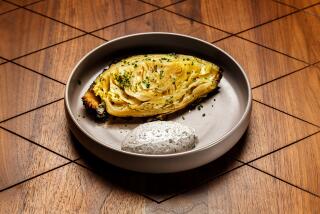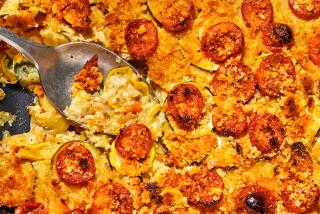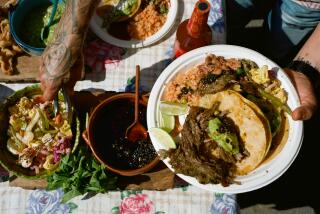A Modern Stone-Age Vegetable
- Share via
Proposed cartoon for our times: A fire burns in a circle of stones. A hefty, bearskin-clad caveman crouches over it, carefully roasting his dinner--not a leg of deer, not a chunk of dinosaur, but a humongous carrot.
These days, no chic restaurant worth its olive oil would dream of being without grilled vegetables, and back-yard chefs across the nation have been following suit.
The only wonder is that it took us so long. As shish-kebab lovers have always known, the browning reactions and smoke flavoring that make grilled meat so appealing have much the same effect on the vegetable kingdom, where they not only heighten the flavor of fresh things but also hide a multitude of out-of-season sins.
Sweet fresh asparagus, for example, gets new depth from grilling, while elderly spears that have lost their savor borrow tastiness from the smoke. Deep grain-flavored corn in season is enhanced by the technique, which gives it an almost meaty taste. The over-sweet shippers’ corn in markets now is saved by fire, which tenderizes those tough kernals and turns the excess of sugar into a whole complex of caramelized appeal.
TIPS FOR GRILLING VEGETABLES
The two key words are careful and covered. Vegetables lack the fat that keeps meat moist; and the high heat that browns things so well can easily burn foods that are high in sugar, such as onions and beets. It’s a balancing act: too slow and the stuff dries up, too fast and it burns. A good general rule of thumb is five minutes to eight minutes total per inch of thickness, in a covered grill. Coals should be at medium heat--test with an onion slice, which should start to brown in about a minute and a half. Turn vegetables with tongs or a spatula to avoid juice-loss.
TO OIL OR NOT TO OIL
Olive oil, with or without herbs and garlic, is almost always called for in grilled vegetable recipes. It does add flavor and prevents sticking, but it can flare up and give charred tastes. And many grilled vegetables--onions and eggplant come at once to mind--taste just as good without the added fat. Better to add it after grilling, except where absolutely necessary to prevent sticking.
VEGETABLES TO PRE-COOK
The variable heat of most back-yard grills forbids long cooking. For best results, steam, microwave or oven-roast the following before finishing on the grill: Carrots, beets (leave the skin on, grill whole and then peel), potatoes (either prepare as beets or grill oiled slices), artichokes (peel off all coarse outer leaves, halve or quarter, remove choke and trim thorns).
VEGETABLES TO COOK DIRECTLY
Asparagus--Use thick spears; the thin ones tend to dry out and get tough.
Cabbage--Remove tough outer leaves, cut into 1 1/2-inch wedges, grill with the core in so they don’t fall apart and remove after they’re cooked.
Corn--Remove tough outer husks. Peel back inner ones, remove silk and replace husks. Soak in cold water for 10 to 15 minutes before cooking. (Don’t water-log or the corn will steam instead of grill.)
Eggplant--Leave peel on, cut crosswise into inch slabs. Taste peel before serving and remove, if bitter.
Greens--Heading greens such as endive, radicchio and lettuce hearts all work well. Oil lightly to prevent desication of outer leaves.
Onions--Peel and cut into 1/2-inch slabs.
Peppers--Leave standard waxed ones whole, char skins, then peel and seed. Wax-free peppers can be halved and seeded before grilling and enjoyed with the skins on.
Summer squash and zucchini--Cut large ones into inch-thick circles or halve lengthwise. Leave small ones whole and keep turning to ensure even cooking.
Tomatoes--They tend to fall apart, but whole ones roasted over low heat until browned and semi-collapsed are delicious ground into sauce.
*
This salad is rich with assertive flavors, smokey and sweet, hot, sharp and citrusy all at once. And it’s filling enough to be a main dish, especially on a hot day. Yet it’s very low in fat, thanks to the buttermilk dressing. (Yes, I know there’s avocado, but only a little. . . .)
GRILLED CORN AND JICAMA SALAD WITH BUTTERMILK DRESSING 1 large tangerine, preferably Minneola 1/2 cup buttermilk 1 tablespoon lemon juice, or more taste 1 tablespoon peanut oil 1 teaspoon Worcestershire sauce 1/2 teaspoon salt, or more to taste Dash ground clove 6 ears corn 1 large sweet onion, such as Vidalia or Maui, cut into 1/2-inch slices
1 medium jicama, about 3/4 pound 2 jalapeno chiles, cut into small dice 1/2 cup coarsely chopped cilantro, plus extra leaves for garnishing 3 cups shredded iceberg or other crisp head lettuce 1 avocado, cut into thin lengthwise slices
Cut off top 1/3 of tangerine. Squeeze out top 1/3 of juice. There should be about 2 tablespoons. Set remaining tangerine aside.
In small, nonreactive bowl, whisk tangerine juice with buttermilk, lemon juice, peanut oil, Worcestershire, salt and clove. Set dressing aside.
Grill corn and onion slices. Cut kernels from cobs. There should be about 4 cups. Place into large, nonreactive bowl. Cut onion into thin slivers and add bowl.
Slice jicama 1/4-inch thick, then peel slices. Cut into 1/4-inch-wide matchsticks, then slice across to make 1/4-inch dice. Add jicama, jalapenos and chopped cilantro to corn mixture.
Recombine dressing. Add to vegetables and stir well. Taste and adjust salt and lemon. Peel and section reserved tangerine.
Divide shredded lettuce among serving plates and top with corn salad. Garnish with avocado slices, tangerine sections and cilantro leaves. Makes 4 main dish servings, or 6 side dish servings.
More to Read
Eat your way across L.A.
Get our weekly Tasting Notes newsletter for reviews, news and more.
You may occasionally receive promotional content from the Los Angeles Times.










